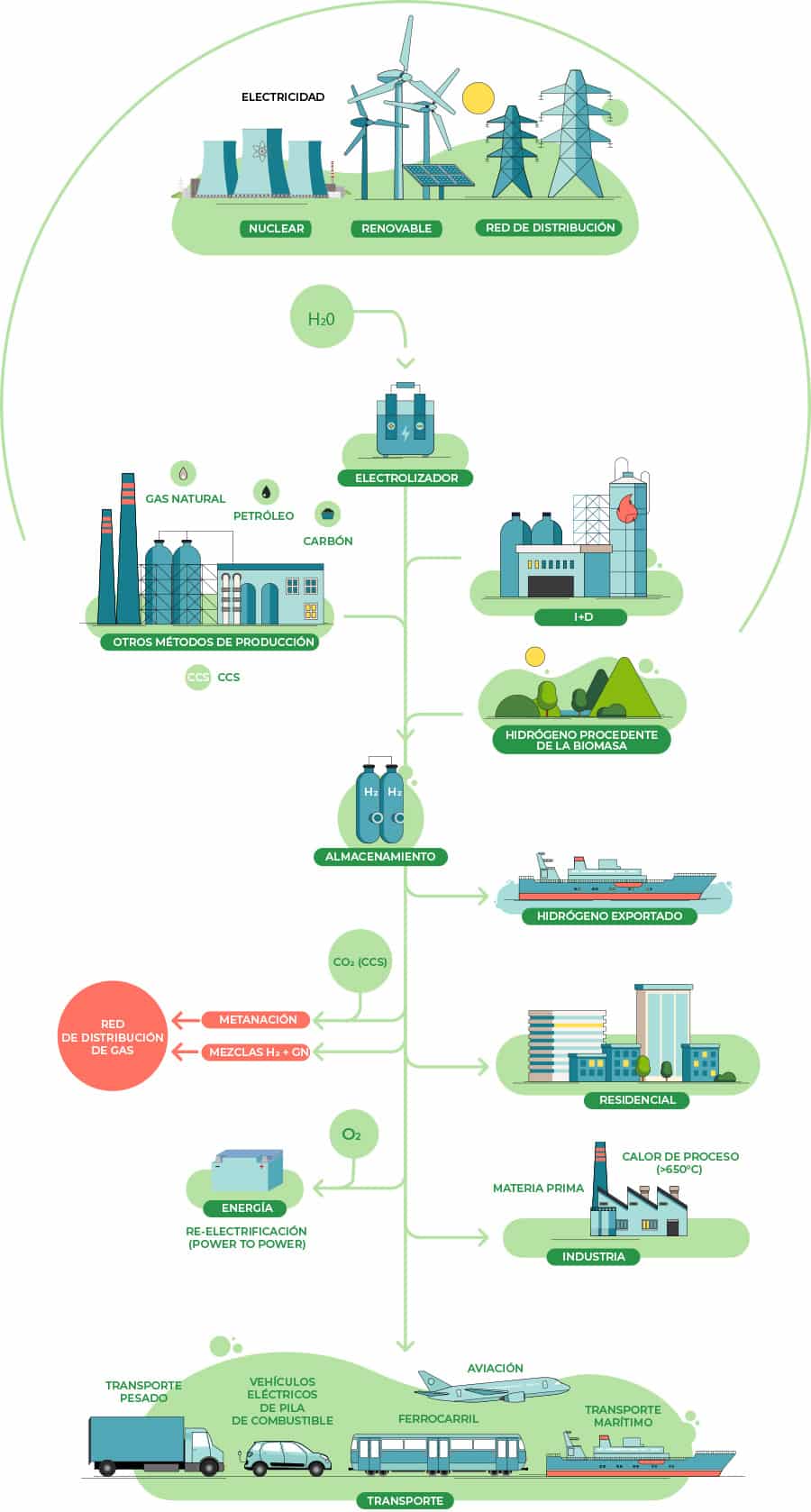INDUSTRY, TRANSPORTATION, BUILDINGS
FACILITATES COUPLING BETWEEN SECTORS AND BETWEEN ENERGY PRODUCTION AND ENERGY DEMAND
Energy can be transferred (through a common energy vector) to the sector that needs it most at any given time, achieving optimal and integral use of existing energy infrastructures. Thanks to hydrogen, it will be possible to channel large amounts of renewable energy and reach sectors whose decarbonization would otherwise be very complex.
HYDROGEN
CHAIN VALUE


PRODUCTION LOCAL AND SUSTAINABLE
A fundamental element to strengthen national energy security, given that hydrogen, can be produced from different energy sources, and through different processes, each region, each country, will be able to produce it locally with their available resources.

PROSPECTIVES
HYDROGEN IN SPAIN
SPAIN
ROAD MAP
Spain has developed a Renewable Hydrogen Roadmap. Besides, hydrogen will play a very relevant role in the post-COVID Recovery Plan and the European Green Pact. This energy vector will be key on the road to climate neutrality.
In this sense, hydrogen can reactivate, redefine and transform the economy; it can generate employment, economic development and, the creation of industry; and increase national energy security.
Spain has clear competitive advantages for hydrogen development in the coming years
Spain, a potential hydrogen exporting country
Given the country’s high renewable resources and its geographical location, the production potential is sufficient to supply local energy needs and export surpluses.
Industry
Specialized, and includes the entire hydrogen value chain. Meet our members.
Technological Capabilities
Necessary to face the sector’s growth expected in the coming years, to meet the objectives set out in the Roadmap.
Installation of at least 4 GW of electrolyzer power

Industry: minimum renewable hydrogen contribution of 25%

150 buses
5,000 – 7,500 LCVs and HDVs

100-150 public-access HRS

2 commercial medium-long distance train lines

Handling machinery for first ports and airports

Environmental impact: reduce emissions by 4.6 Mton CO2 eq.

Estimated investments of 8.9 billion euros

Energy Storage: Commercial Renewable Hydrogen Projects operative by 2030
Spanish Hydrogen Roadmap: a commitment to renewable hydrogen
SPAIN’S VISION FOR 2030
On October 6, 2020, the Council of Ministers, on the proposal of the Ministry for Ecological Transition and the Demographic Challenge (MITECO), approved the “Spanish Hydrogen Roadmap: a commitment to renewable hydrogen”. With this planning, the Government promotes the deployment of this sustainable energy vector, which will be key for Spain to reach climate neutrality, with a 100% renewable electricity system, no later than 2050.
60 Measures and lines of action
4 areas of action:
- Regulatory
- Sectoral
- Cross-sectional nature
- R&D promotion
THE ROLE OF THE SPANISH HYDROGEN ASSOCIATION
Established in 2002, it is the dean and reference association of the sector. For almost 20 years it has been the voice of the companies and organizations working with hydrogen in Spain and its representative before the National Public Administrations and reference organizations in the international energy sector.
The main objective of AeH2 is to enable a favorable environment for the development of hydrogen in Spain and to achieve a strong national industry in the sector.
GATHERING PLACE
Of main players
+ 270 PARTNERS
From across the hydrogen value chain

How is hydrogen produced?
There are different methods of hydrogen production, which use several primary energy sources. Depending on the origin of the energy used in the process, and the emissions associated with it, the hydrogen produced can be classified into different “colors”.
Gray Hydrogen
Gray hydrogen is usually referred to as hydrogen produced from fossil fuel energy sources (natural gas, oil, coal, etc.) with associated pollutant emissions.
There are different production methods, although the most common is steam reforming of natural gas (from which most of today’s hydrogen produced comes) and coal gasification.
There are classification methods (such as the CertifHy project) that also include in this category all hydrogen produced from any source that cannot guarantee its renewable origin through certificates or guarantees of origin (e.g. electricity from the electricity mix).
Blue Hydrogen
Produced from fossil fuel energy sources, but with low associated pollutant emissions (incorporating carbon capture and storage systems to the aforementioned methods).
Turquoise Hydrogen
Recent terminology. This hydrogen is produced upon fossil energy sources, without associated pollutant emissions. This would be the case of natural gas pyrolysis, which produces hydrogen and solid carbon (avoiding polluting CO2 emissions).
Green hydrogen
Also resembled as renewable hydrogen, produced upon renewable energy sources and with low (or zero) associated pollutant emissions. The best acknowledged green hydrogen production method is the electrolysis of water, which consists of separating the water’s molecule into its components (hydrogen and oxygen) by applying electric current in an electrochemical device called an electrolyzer. There are also other methods of renewable hydrogen production such as steam reforming of biogases, bio alcohols or organic wastes, photocatalysis, water thermolysis, production by microorganisms, etc.
How is hydrogen stored?
There are also different methods of hydrogen storage which preference will depend on the restrictions of space, weight, storage time, or cost.

PRESSURIZED
Hydrogen can be stored in a gaseous state in cylindrical or spherical tanks. Additionally, it can be stored at different pressures (the higher the pressure, the greater the amount of hydrogen stored per unit volume).
LIQUID STATE
It requires cryogenic temperatures since its boiling temperature, at ambient pressure, is -253 °C. Storing hydrogen in this way increases its density, making it possible to store a greater quantity, although the cost increases.
SOLID HYDRIDES
Storage in “solid-state”, hydrogen is incorporated into the crystalline structure of certain metals forming “hydrides”, this result in a higher density. One disadvantage of this type of storage is its high weight.
POROUS MATERIALS
By adsorption of porous solids, such as zeolites or carbon nanotubes, on the surface.
ORGANIC LIQUID CARRIERS OR AMMONIA
Through a series of chemical reactions, hydrogen can be transformed into other compounds of higher density that, given their liquid state, are easier to store and/or transport. The most common are ammonia and organic liquid carriers (LOHC).
GAS PIPELINES
The thousands of kilometers of gas pipelines of the national gas infrastructure could be used to store large quantities of hydrogen.
SALT CAVERNS OR DEPLETED RESERVOIRS
Especially envisaged for large-scale and/or long-term storage.
What are the uses of hydrogen?
Hydrogen can be used to produce electricity, heat, synthetic fuels and other chemicals.

HYDROGEN CAN BE USED TO DECARBONIZE
In addition, hydrogen can be used to store large amounts of energy for long periods of time.

ENERGY
Hydrogen’s ability to store energy on a large scale is particularly useful for achieving greater penetration of renewable energies in the electricity mix.

TRANSPORT
Whether used in fuel cell electric vehicles or through hydrogen-based synthetic fuels, it will be possible to decarbonize transportation in all its forms (light and heavy-duty road, rail, maritime, air, etc.).

INDUSTRY
Hydrogen can be used both as a raw material and for high-grade heat generation.

BUILDINGS
Hydrogen can be used to produce the electricity and heat required by buildings, meeting their energy needs with no associated polluting emissions.
RELEVANT HYDROGEN CHATS



